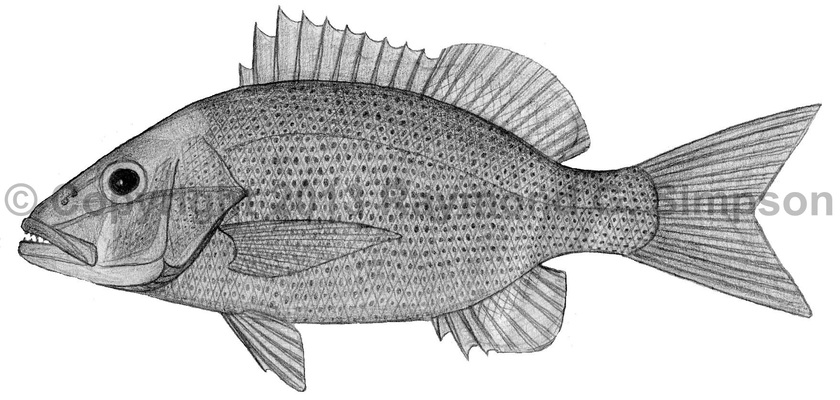
Common Name
Dog Snapper
Year Described
Bloch & Schneider, 1801
Identification
Dorsal Fin: X, 13-14 (usually 14)
Anal Fin: III, 8
Pectoral Fin: 16-17
Gill Rakers: 6-8 upper, 12-14 lower; 19-21 total
Lateral Line Scales: 46-49
Body relatively deep (2.3-2.8 times in SL) and moderately compressed. Upper and lower jaws with a row of conical teeth. Anterior upper jaw teeth enlarged. Vomerine teeth in a anchor-shaped patch with a median extension. Palatine teeth an elongate band. Ectopterygoid teeth absent. Soft dorsal and anal fins with scales on membranes. Maxilla scaleless. No distinct notch between spiny and soft dorsal fins. Last dorsal ray not elongated. Soft dorsal fin rounded. Anal fin rounded. Pectoral fin longer than distance from snout to preopercular margin (3-3.5 times in SL). Caudal fin emarginate.
Color
Body olive grading to whitish on the belly. Scales with darker bases. Body often has reddish, yellowish, or bronze tint. There are sometimes several thin pale bars on the dorsum. A pale triangular marking under the eye is usually obvious. Younger fish with a blue line running from snout to opercle that fades to blue dots in adult fish. Young fish also have a dark eye-stripe. Fins body colored with a reddish sheen.
Size
Maximum size to 90cm TL. Commonly to 60cm TL.
Habitat
Coastal waters around coral reefs and other hard bottom habitats. Juveniles commonly caught in estuarine waters.
Range
New England to NE Brazil, including the Gulf of Mexico and the Caribbean Sea.
References
Anderson, W.D. 2002. Lutjanidae (pp. 1479-1504). In: Carpenter. 2002. The living marine resources of the Western Central Atlantic. Vol. 3: Bony fishes part 2 (Opistognathidae to Molidae). FAO Species Identification Guides for Fisheries Purposes. American Society of Ichthyologists and Herpetologists Special Publication No. 5. FAO of the U.N., Rome.